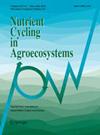根据生长条件的空间变化调整氮肥施用以提高氮素利用效率
IF 2.7
3区 农林科学
Q2 SOIL SCIENCE
引用次数: 0
摘要
摘要/ Abstract摘要:林栖草地近树牧草产量低于露天草地。这与靠近林木线的地区氮素吸收量较低有关。调整氮素的空间投入,减少氮素的总量,可以提高全田氮素的利用效率。我们进行了为期2年的田间试验,通过研究草地对肥料N输入的响应与树木的距离的关系,来深入了解这一节省N输入的想法。我们假设氮素输入率和林木线位置对草地牧草产量和氮素吸收以及氮素利用效率存在交互作用。田间试验在德国的一个银林系统中进行,包括因素年(2019年和2020年)、位置(距林木线2.5、6.5和24.5 m)、年施氮量(0、15和30 g N m - 2)和收获日期(每年四次收获)。我们发现所有目标变量的位置× N率之间存在显著的相互作用,通常也与收获日期或年份存在相互作用。离树木较近处的施氮量<在大多数情况下,6.5 m对牧草产量没有显著影响,但在更远的位置显著提高了牧草产量,最高可达35%。在树木附近6.5 m的廊道内不施氮肥可以直接节约氮肥,而不会对牧草生产产生负面影响。本文章由计算机程序翻译,如有差异,请以英文原文为准。
Adjusting nitrogen fertilization to spatial variations in growth conditions in silvopastoral systems for improved nitrogen use efficiency
Abstract Grass swards in silvopastoral systems have a lower herbage production near trees than open grassland. This is related to a lower nitrogen (N) uptake in an area close to the tree lines. The N use efficiency for the whole field can then be improved when N input is spatially adjusted and the overall amount reduced. We performed a 2-year field experiment to gain insights into this idea for making savings on N inputs by studying the response of the grass sward to fertilizer N input in relation to the distance from trees. We hypothesized an interaction between N input rate and position to the tree line on grassland herbage production and N uptake and, accordingly, N use efficiency. The field trial was carried out in a silvopastoral system in Germany consisting of the factors year (2019 and 2020), position (2.5, 6.5 and 24.5 m distances to tree line), annual N application rate (0, 15 and 30 g N m −2 ) and harvest date (four harvests per year). We found significant interactions between position × N rate for all target variables, and usually also in interactions with the harvest date or year. The N application close to trees at a distance < 6.5 m had in most cases no significant influence on herbage production but significantly increased herbage production by up to 35% at positions further away. Omitting the N fertilization in a corridor of 6.5 m near the trees would contribute directly to the saving of fertilizer N without a negative trade-off in herbage production.
求助全文
通过发布文献求助,成功后即可免费获取论文全文。
去求助
来源期刊

Nutrient Cycling in Agroecosystems
农林科学-土壤科学
CiteScore
5.90
自引率
3.20%
发文量
61
审稿时长
4.5 months
期刊介绍:
Nutrient Cycling in Agroecosystems considers manuscripts dealing with all aspects of carbon and nutrient cycling as well as management and examining their effect in ecological, agronomic, environmental and economic terms. Target agroecosystems include field crop, organic agriculture, urban or peri-urban agriculture, horticulture, bioenergy, agroforestry, livestock, pasture, and fallow systems as well as their system components such as plants and the fertility, chemistry, physics or faunal and micro-biology of soils. The scale of observation is the cycles in the soil-plant-animal system on or relevant to a field or watershed level as well as inputs from or losses to the anthroposphere, atmosphere and hydrosphere. Studies should thus consider the wider system in the examination of cycling and fluxes in agroecosystems or their components. These may include typically multi-year field observations, farm gate budgets, watershed studies, life cycle assessments, enterprise and economic analyses, or regional and global modeling. Management objectives may not only include the maximization of food, fiber and fuel production, but also its environmental and economic impact. The results must allow mechanistic conclusions of broad applicability and distinguish itself from empirical results or case studies of merely local or regional importance. If unsure whether a study fits into this scope, please contact the editor with a brief inquiry before manuscript submission.
 求助内容:
求助内容: 应助结果提醒方式:
应助结果提醒方式:


